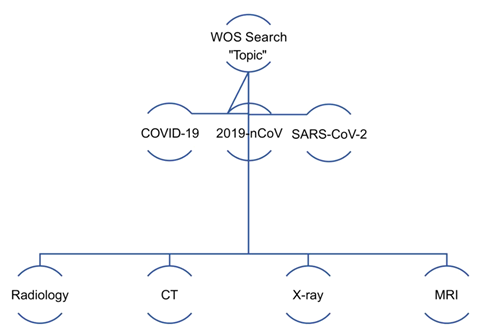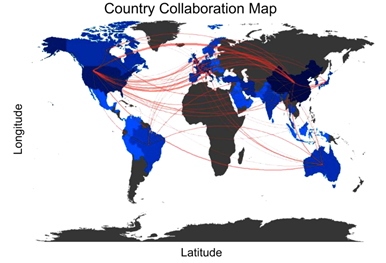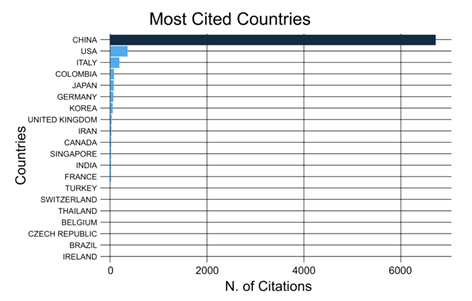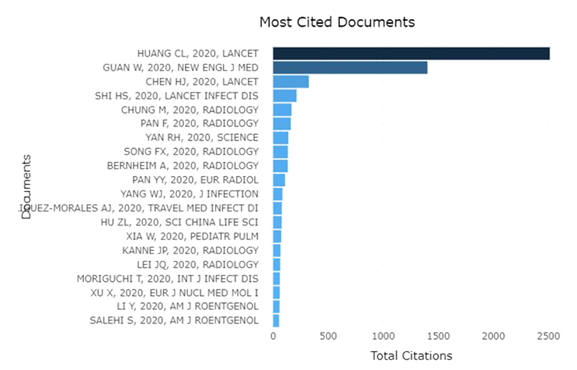SARS-CoV-2 in the Field of Radiology: A Bibliometric Study of the Novel Coronavirus Disease
Article Information
Emre Pakdemirli1, Urszula Wegner2*, Sherif Monib3
1Consultant Radiologist, Department of Radiology, West Hertfordshire Hospitals NHS, St. Albans City Hospital, St. Albans, UK
2Consultant Radiologist, United Lincolnshire Hospitals NHS Trust, UK
3Consultant Surgeon, Surgery Department West, Hertfordshire NHS Trust, UK
*Corresponding Author: Dr. Urszula Wegner, Consultant Radiologist, United Lincolnshire Hospitals NHS Trust, UK
Received: 22 November 2020; Accepted: 10 December 2020; Published: 14 December 2020
Citation: Emre Pakdemirli, Urszula Wegner, Sherif Monib. SARS-CoV-2 in the Field of Radiology: A Bibliometric Study of the Novel Coronavirus Disease. Journal of Radiology and Clinical Imaging 3 (2020): 099-109.
Share at FacebookAbstract
To the best of our knowledge, there are few publications regarding bibliometric analyses of SARSCoV-2 in English and this is one of the most comprehensive studies in the field of clinical imaging set in database coverage. The initial, underestimated, severe acute respiratory syndrome coronavirus 2 of the genus Betacoronavirus (SARS-CoV-2) pandemic remains an ongoing major health crisis and a challenge to public healthcare systems worldwide. Subsequently, there have been rapidly increasing numbers of scientific publications about this emerging area of research. The aim of this study was to analyze research trends and explore the influence of scientific publications on coronavirus disease 2019 (COVID-19) in terms of publication type, language, country of origin, publication citation, and journal medical field. A bibliometric study with high emphasis on publications retrieved from the Web of Science database from January to July 2020 was conducted. Data were extracted using the following keywords: 2019-nCoV, SARS-CoV-2, Radiology, COVID-19, Radiology, COVID-19 and X-Ray, COVID-19 and Ultrasound, COVID-19 and CT, COVID-19, and MRI. The majority of extracted scientific publications were free full-text articles in English. Interestingly, no published books and only a few randomized controlled trials were found. China and the United States of America contributed the most highly cited scientific papers in the academic literature. Institutional ethical approval to conduct our study was not necessary, as all data were available in electronic versions online and in libraries. Statistical evaluation of publications on COVID-19 is crucial to measure the impact of research outputs in the scientific community and is important for future quality planning of management and protective strategies.
Keywords
COVID-19; SARS-CoV-2; Bibliometric analysis; Radiology; Pandemic
COVID-19; SARS-CoV-2; Bibliometric analysis; Radiology; Pandemic
COVID-19 articles COVID-19 Research articles COVID-19 review articles COVID-19 PubMed articles COVID-19 PubMed Central articles COVID-19 2023 articles COVID-19 2024 articles COVID-19 Scopus articles COVID-19 impact factor journals COVID-19 Scopus journals COVID-19 PubMed journals COVID-19 medical journals COVID-19 free journals COVID-19 best journals COVID-19 top journals COVID-19 free medical journals COVID-19 famous journals COVID-19 Google Scholar indexed journals SARS-CoV-2 articles SARS-CoV-2 Research articles SARS-CoV-2 review articles SARS-CoV-2 PubMed articles SARS-CoV-2 PubMed Central articles SARS-CoV-2 2023 articles SARS-CoV-2 2024 articles SARS-CoV-2 Scopus articles SARS-CoV-2 impact factor journals SARS-CoV-2 Scopus journals SARS-CoV-2 PubMed journals SARS-CoV-2 medical journals SARS-CoV-2 free journals SARS-CoV-2 best journals SARS-CoV-2 top journals SARS-CoV-2 free medical journals SARS-CoV-2 famous journals SARS-CoV-2 Google Scholar indexed journals Pandemic articles Pandemic Research articles Pandemic review articles Pandemic PubMed articles Pandemic PubMed Central articles Pandemic 2023 articles Pandemic 2024 articles Pandemic Scopus articles Pandemic impact factor journals Pandemic Scopus journals Pandemic PubMed journals Pandemic medical journals Pandemic free journals Pandemic best journals Pandemic top journals Pandemic free medical journals Pandemic famous journals Pandemic Google Scholar indexed journals Radiology articles Radiology Research articles Radiology review articles Radiology PubMed articles Radiology PubMed Central articles Radiology 2023 articles Radiology 2024 articles Radiology Scopus articles Radiology impact factor journals Radiology Scopus journals Radiology PubMed journals Radiology medical journals Radiology free journals Radiology best journals Radiology top journals Radiology free medical journals Radiology famous journals Radiology Google Scholar indexed journals Bibliometric analysis articles Bibliometric analysis Research articles Bibliometric analysis review articles Bibliometric analysis PubMed articles Bibliometric analysis PubMed Central articles Bibliometric analysis 2023 articles Bibliometric analysis 2024 articles Bibliometric analysis Scopus articles Bibliometric analysis impact factor journals Bibliometric analysis Scopus journals Bibliometric analysis PubMed journals Bibliometric analysis medical journals Bibliometric analysis free journals Bibliometric analysis best journals Bibliometric analysis top journals Bibliometric analysis free medical journals Bibliometric analysis famous journals Bibliometric analysis Google Scholar indexed journals X-Ray articles X-Ray Research articles X-Ray review articles X-Ray PubMed articles X-Ray PubMed Central articles X-Ray 2023 articles X-Ray 2024 articles X-Ray Scopus articles X-Ray impact factor journals X-Ray Scopus journals X-Ray PubMed journals X-Ray medical journals X-Ray free journals X-Ray best journals X-Ray top journals X-Ray free medical journals X-Ray famous journals X-Ray Google Scholar indexed journals CT articles CT Research articles CT review articles CT PubMed articles CT PubMed Central articles CT 2023 articles CT 2024 articles CT Scopus articles CT impact factor journals CT Scopus journals CT PubMed journals CT medical journals CT free journals CT best journals CT top journals CT free medical journals CT famous journals CT Google Scholar indexed journals radiological imaging articles radiological imaging Research articles radiological imaging review articles radiological imaging PubMed articles radiological imaging PubMed Central articles radiological imaging 2023 articles radiological imaging 2024 articles radiological imaging Scopus articles radiological imaging impact factor journals radiological imaging Scopus journals radiological imaging PubMed journals radiological imaging medical journals radiological imaging free journals radiological imaging best journals radiological imaging top journals radiological imaging free medical journals radiological imaging famous journals radiological imaging Google Scholar indexed journals reverse transcription polymerase chain reaction articles reverse transcription polymerase chain reaction Research articles reverse transcription polymerase chain reaction review articles reverse transcription polymerase chain reaction PubMed articles reverse transcription polymerase chain reaction PubMed Central articles reverse transcription polymerase chain reaction 2023 articles reverse transcription polymerase chain reaction 2024 articles reverse transcription polymerase chain reaction Scopus articles reverse transcription polymerase chain reaction impact factor journals reverse transcription polymerase chain reaction Scopus journals reverse transcription polymerase chain reaction PubMed journals reverse transcription polymerase chain reaction medical journals reverse transcription polymerase chain reaction free journals reverse transcription polymerase chain reaction best journals reverse transcription polymerase chain reaction top journals reverse transcription polymerase chain reaction free medical journals reverse transcription polymerase chain reaction famous journals reverse transcription polymerase chain reaction Google Scholar indexed journals Ultrasound articles Ultrasound Research articles Ultrasound review articles Ultrasound PubMed articles Ultrasound PubMed Central articles Ultrasound 2023 articles Ultrasound 2024 articles Ultrasound Scopus articles Ultrasound impact factor journals Ultrasound Scopus journals Ultrasound PubMed journals Ultrasound medical journals Ultrasound free journals Ultrasound best journals Ultrasound top journals Ultrasound free medical journals Ultrasound famous journals Ultrasound Google Scholar indexed journals
Article Details
1. Introduction
Novel coronavirus, COVID-19, also known as SARS-CoV-2, was first identified in Wuhan, Hubei Province, in the Republic of China in December 2019 [1, 2]. Since the novel virus could remain viable and highly infectious in the form of aerosols or droplets, the disease has a significant potential to escalate rapidly across continents [3]. The symptoms of disease vary from asymptomatic presentations or mild respiratory symptoms to severe pneumonia with neurological, cardiovascular complications, or even multiple organ failure. Both symptomatic and asymptomatic community transmission contributed to an alarming increase in new cases [4-7]. The World Health Organization announced a worldwide pandemic in March 2020 and subsequently encouraged the public to strengthen and implement protective measures to minimize the spread of COVID-19 [8]. Careful calculation and analysis of the published resources extracted from Web of Science is helpful to recognize research gaps in publication types and scientific fields. Such investigations can shed light on our ability to cope with unexpected challenges. Since the radiological imaging spectrum plays a pivotal role in establishing correct diagnoses along with reverse transcription polymerase chain reaction (RTPCR) testing, a statistical quantitative evaluation of the increasing number of associated publications parallel to the surge of the disease in radiological sciences was conducted.
To the best of our knowledge, there have been few publications of bibliometric analyses of SARS-CoV-2 in English literature, despite this being one of the most comprehensive studies in the field of clinical imaging set in database coverage. Shortly after the virus outbreak, there were numerous significant scholarly publications in the medical literature. Thus, the purpose of our bibliometric study is to investigate the impact of academic literature on emerging infectious diseases. Moreover, the main aim is to analyze the progression of research trends and potential scenarios of future pandemics. Thus, this study explored the influence of scientific publications on COVID-19 in terms of publication type, language, country of origin, publication citation, and journal medical field.
2. Materials and Methods
An extensive Web of Science database search was conducted on July 12, 2020, and radiology publications associated with COVID-19 were retrieved. The timeframe related to our search included published scientific papers from January 2020 until July 12, 2020. A few keywords were searched, namely, 2019-nCoV, SARS-CoV-2, Radiology, COVID-19 and Radiology, COVID-19 and X-Ray, COVID-19 and Ultrasound, COVID-19 and CT, COVID-19, and MRI (Figure 1). A comprehensive data search in the Web of Science (WOS) included 668 manuscripts from 60 countries. MS Excel and R Studio with Bibliometrix R package software were used for the study. A thorough analysis of predominant variables was performed: “WOS Category,” “Publication Year,” “Document Type,” “Organization,” “Funding,” “Author,” “Source Title,” “Country,” “Language,” and “Research Area.”

Figure 1: Collation of search keywords used for the dataset and research output about the novel coronavirus.
Note. COVID-19: coronavirus disease of 2019, CT: Computerized tomography scan, MRI: Magnetic resonance imaging, SARS-CoV-2: severe acute respiratory syndrome coronavirus 2 of the genus Betacoronavirus, WOS: Web of Science.
3. Results
Unsurprisingly, the overwhelming majority of the 688 research papers from 60 countries were in English and represented approximately 97.7% of our records (Table 1). Most retrieved scientific items were original articles, approximately 60.47% (Table 2). Moreover, retrieved data show that China and the USA collaborated most actively and were the main contributing countries with respect to the number of citations (Figures 2 and 3). Not surprisingly, Chinese institutions such as Huazhong University of Science and Technology in Wuhan, Wuhan University, and Sun Yat-sen University in Guangzhou, China, produced the highest numbers of COVID-19 publications (Table 3).
|
Languages |
Records |
% of 668 |
|
ENGLISH |
654 |
97,904 |
|
GERMAN |
4 |
0,599 |
|
FRENCH |
3 |
0,449 |
|
HUNGARIAN |
2 |
0,299 |
|
CZECH |
1 |
0,15 |
|
ITALIAN |
1 |
0,15 |
|
NORWEGIAN |
1 |
0,15 |
|
PORTUGUESE |
1 |
0,15 |
|
TURKISH |
1 |
0,15 |
Table 1: Languages analysis of scientific manuscripts reveal that the majority were published in English.
|
Document Types |
Records |
% of 668 |
|
Article |
404 |
60,479 |
|
Early Access |
146 |
21,856 |
|
Letter |
112 |
16,766 |
|
Review |
79 |
11,826 |
|
Editorial Material |
71 |
10,629 |
|
Correction |
1 |
0,15 |
|
News Item |
1 |
0,15 |
Table 2: Records for majority type of publications.

Figure 2: Country collaboration map.
Note. Mapping visualization of continental activity and collaboration related to COVID-19. Developing countries are the minority in terms of research collaboration on the novel disease. China, USA, and Western Europe are the main global scientific collaborators.

Figure 3: Most cited countries.
Note. N: Number
|
Organizations-Enhanced |
records |
% of 668 |
|
HUAZHONG UNIVERSITY OF SCIENCE TECHNOLOGY |
43 |
6.437 |
|
SUN YAT SEN UNIVERSITY |
37 |
5.539 |
|
WUHAN UNIVERSITY |
27 |
4.042 |
|
SHAHID BEHESHTI UNIVERSITY MEDICAL SCIENCES |
19 |
2.844 |
|
ASSISTANCE PUBLIQUE HOPITAUX PARIS APHP |
18 |
2.695 |
|
SICHUAN UNIVERSITY |
17 |
2.545 |
|
CATHOLIC UNIVERSITY OF THE SACRED HEART |
15 |
2.246 |
|
IRCCS POLICLINICO GEMELLI |
15 |
2.246 |
|
UNIVERSITY OF LONDON |
15 |
2.246 |
|
CAPITAL MEDICAL UNIVERSITY |
14 |
2.096 |
|
ZHEJIANG UNIVERSITY |
14 |
2.096 |
|
CHINESE ACADEMY OF MEDICAL SCIENCES PEKING UNION MEDICAL COLLEGE |
13 |
1.946 |
|
CHINESE ACADEMY OF SCIENCES |
11 |
1.647 |
|
CHINESE UNIVERSITY OF HONG KONG |
11 |
1.647 |
|
FUDAN UNIVERSITY |
11 |
1.647 |
|
TEHRAN UNIVERSITY OF MEDICAL SCIENCES |
11 |
1.647 |
|
UNIVERSITY OF CALIFORNIA SYSTEM |
11 |
1.647 |
|
GUANGZHOU MEDICAL UNIVERSITY |
10 |
1.497 |
|
SHANGHAI JIAO TONG UNIVERSITY |
10 |
1.497 |
|
GUIZHOU MEDICAL UNIVERSITY |
9 |
1.347 |
|
UNIVERSITY OF MILAN |
9 |
1.347 |
|
UNIVERSITY OF TEXAS SYSTEM |
9 |
1.347 |
|
UNIVERSITY OF WASHINGTON |
9 |
1.347 |
|
UNIVERSITY OF WASHINGTON SEATTLE |
9 |
1.347 |
|
CHONGQING MEDICAL UNIVERSITY |
8 |
1.198 |
|
HUBEI UNIVERSITY OF MEDICINE |
8 |
1.198 |
|
JIANGXI PROV PEOPLES HOSP |
8 |
1.198 |
|
LANZHOU UNIVERSITY |
8 |
1.198 |
|
SINGAPORE GENERAL HOSPITAL |
8 |
1.198 |
|
SORBONNE UNIVERSITE |
8 |
1.198 |
|
SOUTHERN MEDICAL UNIVERSITY CHINA |
8 |
1.198 |
|
UNIVERSITY COLLEGE LONDON |
8 |
1.198 |
|
UNIVERSITY OF PENNSYLVANIA |
8 |
1.198 |
|
UNIVERSITY OF SOUTHERN CALIFORNIA |
8 |
1.198 |
|
WUHAN UNIVERSITY OF SCIENCE TECHNOLOGY |
8 |
1.198 |
|
XI AN JIAOTONG UNIVERSITY |
8 |
1.198 |
Table 3: Results of the highest number of citations among countries.
Enhanced bibliometric analysis revealed the most contributing universities producing the highest numbers of scientific publications. The analysis indicated that European Radiology and Journal of Infection were the main comprehensive bibliometric sources at the time of our search (Table 4). However, the most influential documents were from the New England Journal of Medicine and Lancet. The top cited publications were Huang CL, 2020, Lancet, and Guan W, 2020, New England Journal of Medicine (Figure 4). Interestingly, the book search resulted in “zero entries” and only limited randomized controlled trials were found. Therefore, bibliometric outcomes regarding publications of this type represent probable scientific gaps and potential near-future priority in this novel, rapidly emerging research field.
|
Source Titles |
Records |
% of 668 |
|
EUROPEAN RADIOLOGY |
34 |
5.09 |
|
JOURNAL OF INFECTION |
27 |
4.042 |
|
EUROPEAN JOURNAL OF NUCLEAR MEDICINE AND MOLECULAR IMAGING |
21 |
3.144 |
|
AMERICAN JOURNAL OF ROENTGENOLOGY |
20 |
2.994 |
|
ACADEMIC RADIOLOGY |
17 |
2.545 |
|
CUREUS |
16 |
2.395 |
|
QUANTITATIVE IMAGING IN MEDICINE AND SURGERY |
16 |
2.395 |
|
KOREAN JOURNAL OF RADIOLOGY |
15 |
2.246 |
|
JAPANESE JOURNAL OF RADIOLOGY |
12 |
1.796 |
|
RADIOLOGY |
12 |
1.796 |
|
ANNALS OF TRANSLATIONAL MEDICINE |
11 |
1.647 |
|
JOURNAL OF MEDICAL VIROLOGY |
11 |
1.647 |
|
JOURNAL OF THE AMERICAN COLLEGE OF RADIOLOGY |
10 |
1.497 |
|
RADIOLOGIA MEDICA |
10 |
1.497 |
|
EMERGENCY RADIOLOGY |
9 |
1.347 |
|
INTERNATIONAL JOURNAL OF INFECTIOUS DISEASES |
9 |
1.347 |
|
EUROPEAN JOURNAL OF RADIOLOGY |
8 |
1.198 |
|
FRONTIERS IN MEDICINE |
8 |
1.198 |
|
ULTRASOUND IN OBSTETRICS GYNECOLOGY |
8 |
1.198 |
|
CLINICAL RADIOLOGY |
7 |
1.048 |
|
JOURNAL OF ULTRASOUND IN MEDICINE |
7 |
1.048 |
|
DIAGNOSTIC AND INTERVENTIONAL IMAGING |
6 |
0.898 |
|
INTENSIVE CARE MEDICINE |
6 |
0.898 |
|
TRIALS |
6 |
0.898 |
Table 4: Bibliometric analysis as per journal titles.

Figure 4: Statistical collation of most cited documents.
Additionally, continental activity and collaboration among various countries appears limited to particular regions. More datasets or contributions from developing countries would be a valuable asset not only for bibliometric studies but also for the revision of and contributions to current global knowledge. Overall, a more supportive approach to developing countries to enable more scientific opportunities and greater access to datasets could be considered another area of improvement (Figure 2). Impressively, we identified a sharp increase in publication numbers when allowing for our preliminary data search from July 6, 2020, at 9 am to repeat, as the number of items increased by seven on the same day shortly after, at 10:45 am. Thus, there are positive increasing research waves on short time scales that promote better access to timely and reliable information sources.
4. Discussion
Bibliometric studies emphasizing the quantitative and qualitative evaluation of publications represent a highly sensitive and valuable tool that can reveal and summarize global scientific trends [9-10]. Since a response to SARS-CoV-2 has strongly encouraged academic research, we observe the subsequent rapid growth of high-quality scientific publications. A significant volume of papers was published in journals with the highest impact factors. Not surprisingly, the New England Journal of Medicine and Lancet journals ranked first in top-cited publications worldwide.
China, the United States of America, and Western European countries represent the main scientific landscape and are highly connected in information flow and scientific progress on the novel disease (Figure 2). This could be attributed to more optimal research conditions, including satisfactory resources with appropriate levels of funding and a high number of cases in the regions. Nevertheless, according to the visualization map, there is a potential limitation of our analysis, and significant databases appearing to fall outside of our scope, as our mapping clearly highlights the need to encourage a number of countries, predominantly those with a lower research budget. It should be noted that empowering these potential future collaborators or building further scientific networks could contribute to further international developments and be helpful to transform current research advancements [10]. Overall, the research shows that insufficient collaboration among countries should be identified as a weakening research factor. Notably, since novel viruses have impacted many specializations in various fields, bibliometric results emphasize multidisciplinary collaborative efforts with great variability of aims and scope regarding extracted journals, including nuclear medicine, molecular imaging, virology, infectious diseases, surgery, and gynecology. Furthermore, journals with completely different aims and scope, such as European Radiology and the Journal of Infection, were identified among the main sources of retrieved scientific papers (Table 4).
Given that new knowledge of the disease is still dynamically evolving, our study represents a relatively early bibliometric analysis, revealing the need for more contributions to fill in the scientific gaps highlighted above. The limited number of randomized controlled trial reports draws attention to an urgent need for more therapeutic guidelines and optimal management options that could lead to improvements in affected patients [11-14]. Moreover, since the majority of important academic events and annual congresses have been cancelled or postponed indefinitely in order to limit physical presence and the spread of infectious diseases, it is crucial to highlight the increasing role of virtual collaboration in telemedicine or teleradiology to shape our future scientific perspectives [13].
5. Conclusions
Illustrated bibliometric analysis represents one of the most up-to-date comprehensive studies in extensive data search coverage and international scientific literature. The study clearly demonstrates that influential publications related to the novel virus are dynamically evolving in a short period. The knowledge domain regarding SARS-CoV-2 still represents a new area of interest among researchers, and detailed bibliometric studies can provide substantial updates on valuable insights, highlight future trends, and address gaps in academic literature.
We emphasize that no hardcopy or eBooks on the coronavirus were found. Even allowing for considerable free online data, broad-ranging books with case review series related to COVID-19 imaging spectrum could be of great interest and represent effective learning tools for both clinicians and dedicated radiologists. Since infectious coronaviruses affect many people worldwide and remain a major global threat, reliable scientific publications of all types are in high demand and there is a subsequent sharp increase in the number of published items.
Even though China and the United States of America have most actively contributed advances to this field of science, it is imperative to highlight that many developing countries could add substantial value in terms of collaboration and research. Thus, an approach encouraging more scientific opportunities or greater funding within the regions with a lower human development index could be helpful in terms of research progress.
References
- Zhu N, Zhang D, Wang W, et al. A novel coronavirus from patients with pneumonia in China, 2019. N Engl J Med 382 (2020): 727-773.
- Li Q, Guan X, Wu P, et al. Early transmission dynamics in Wuhan, China of novel corona virus infected pneumonia. N Engl J Med 382 (2020): 1199-1207.
- van Doremalen N, Bushmaker T, Morris DH, et al. Aerosol and surface stability of SARS-CoV-2 as compared with SARS-CoV-1. N Engl J Med 382 (2020):1564-1567.
- Ye Z, Zhang Y, Wang Y, et al. Chest CT manifestations of new coronavirus disease 2019 (COVID-19): A pictorial review. Eur Radiol 30 (2020): 4381-4389.
- Salehi S, Abedi A, Balakrishnan S, et al. Coronavirus disease 2019 (COVID-19): A systematic review of imaging findings in 919 patients. AJR Am J Roentgenol 215 (2020): 87-93.
- Kong W, Agarwal PP. Chest imaging appearance of COVID-19 infection. Radiol Cardiothorac Imaging 2 (2020): e200028.
- Paules CI, Marston HD, Fauci AS. Coronavirus infections: More than just the common cold. JAMA 323 (2020): 707-708.
- Sohrabi C, Alsafi Z, O’Neill N, et al. World Health Organization declares global emergency: A review of the 2019 novel coronavirus (COVID-19). Int J Surg 76 (2020): 71-76.
- Chahrour M, Assi S, Bejjani M, et al. A bibliometric analysis of COVID-19 research activity: A call for increased output. Cureus 12 (2020): e7357.
- De Felice F, Polimeni A. Coronavirus disease (COVID-19): A machine learning bibliometric analysis. In Vivo 34 (2020): 1613-1617.
- Cao B, Wang Y, Wen D, et al. A trial of lopinavir-ritonavir in adults hospitalized with severe COVID-19. N Engl J Med 382 (2020): 1787-1799.
- Wang M, Cao R, Zhang L, et al. Remdesivir and chloroquine effectively inhibit the recently emerged novel coronavirus (2019-nCoV) in vitro. Cell Res 30 (2020): 269-271.
- Spinelli A, Pellino G. COVID-19 pandemic: Perspectives on an unfolding crisis. Br J Surg 107 (2020): 785-787.
